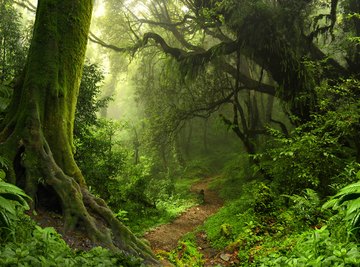
Jungles evoke images of steamy, densely overgrown forests with twisted vegetation and monkeys that swing from tree to tree. Although many ecologists strictly use the term to describe low forests with thick, tangled understories, popular usage equates jungle with tropical rain forest. Jungles consist of trees that require the year-round warm temperatures and high humidity of tropical zones. They are found on five of Earth’s continents. Although trees in jungles tend to have similar physical appearances and structures, the species diversity numbers in the thousands, with as many as 20 to 86 different species of trees per acre.
TL;DR (Too Long; Didn't Read)
Tropical rain forest, often popularly called "jungle," typically supports multilayered canopies composed of many different kinds of trees. Dozens of tree species may grow per acre in these rich, often towering ecosystems.
Rain Forest Characteristics
Dense rain forests boast tightly closed canopies that prevent sunlight from reaching the floor. They primarily flourish in regions with heavy rainfall throughout the year – though similar tropical forests grow in monsoon zones – along with high humidity and temperatures. They consist of four distinct layers: emergent, canopy, understory and forest floor. Trees adapt for sunlight and water. Emergent trees tend to be broad-leaved evergreens and stand far above the canopy, while canopy trees have smooth leaves with deep veins or points called "drip tips" that help move water off leaf. Understory leaves grow larger to capture weak sunlight. Few plants thrive in the dark, relatively dry forest floor; most of the diverse flora and fauna exists in the upper canopies.
Central America Jungles
Rain forests stretch from southern Mexico throughout the length of Central America. The diversity is rich, with up to 90 species per two acres. Some familiar Central American rain forest trees include kapok, Brazil nut, Cecropia, annatto, chewing gum tree (also called chicle), abiu, mountain soursop, ilama, Astrocaryum jauari palm and the rubber tree.
South America's Amazon Rainforest
The Amazon rain forest is the largest on the planet. Approximately 16,000 tree species, with 227 hyperdominant species, were found in the Amazon’s lowland rain forest alone, according a 2013 report in the journal Science. Some common dominant trees include those of the Brazil nut family (Lecythidaceae), the nutmeg family (Myristicaceae) and palm family (Palmaceae). Many are known for commercial value, including rubber tree, cacao, kapok tree, freijo, aҫaí palm and balsa.
Central Africa's Congo
The rain forest of central Africa’s Congo Basin ranks second in size after the Amazon and plays host to more than 10,000 plant species. Important commercial trees include African mahogany, gaboon and utile. Utile, an emergent tree, reaches heights of 200 feet with narrow buttresses – common among emergent rain forest trees as structural support – at the ground.
South Asia
South Asian jungles – which exist today in Brunei, Cambodia, Indonesia, Laos, Malaysia, Myanmar, the Philippines, Thailand and Vietnam – possess plant diversity greater than the Amazon or central Africa. Cinnamon grows wild in Southeast Asia, India and Sri Lanka. Jelutong – a tall, fine-textured tree – is valued for wood-carving as well as for latex. Dipterocarps, reaching heights up to 120 feet, tower over these rain forests as emergent trees providing habitat for bees that suspend their large wedge-shaped hives under the tree’s branches. Dipterocarps are valued more for their bees than for their very hard wood.
Australasia
Australasian rain forests grow in Australia’s Northern Territory, Queensland and New South Wales as well as New Guinea – home to most of the rain forest in this zone – and Melanesian islands such as Fiji. The aggressive strangler fig grows around host trees in this region as it stretches from the forest floor for some highly valued sunlight. A familiar houseplant, umbrella tree – also called schefflera – becomes a large tree but also grows as an epiphyte, piggybacking on larger trees in the canopy. Cycads and coffee constitute important members of this community.
References
About the Author
Kelvin O'Donahue has been writing since 1979, with work published in the "Arizona Geological Society Digest" and "Bulletin of the American Association of Petroleum Geologists," as well as online. O'Donahue holds a Master of Science in geology from the University of Arizona, and has worked in the oil industry since 1982.
